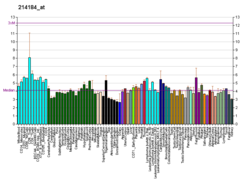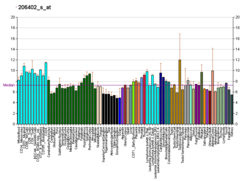Top Qs
Timeline
Chat
Perspective
Neuropeptide FF
Protein-coding gene in the species Homo sapiens From Wikipedia, the free encyclopedia
Remove ads
Neuropeptide FF (NPFF, FLFQPQRFa) is a mammalian amidated neuropeptide originally isolated from bovine brain and characterized as a pain-modulating peptide, with anti-opioid activity on morphine-induced analgesia.

In humans, neuropeptide FF peptides are encoded by the NPFF gene. Two genes encoding two different receptors (NPFF1 and NPFF2) and two precursors [NPFFA (this gene) and NPFFB (NPVF)] have been cloned in several mammalian species.[5][6][7][8]
Remove ads
Processing
Processing of the NPFFA precursor at basic proteolytic sites generates a NPFF-containing peptide with three additional N-terminal amino acids different between species, and a NPSF (SLAAPQRFa)-containing peptide, the length of which depends on the species. NPFFB, identified as a precursor for RFamide-related peptides (RFRPs, also called GnIH for gonadotropin inhibitory hormone), contains a LPLRFa-containing peptide and a peptide sharing with NPFF the same C-terminal PQRFamide motif, such as NPVF (VPNLPQRFa) in human.
Remove ads
Function
Summarize
Perspective
Neuropeptide FF (NPFF) and several other RFamide related peptides issued from two precursors, interact with varying affinity with two subtypes of G protein-coupled receptors, namely NPFF1 and NPFF2 subtypes and are involved in several physiological functions such as cardiovascular regulation, hormonal control, macrophage activation, body temperature homeostasis and pain modulation.[6]
NPFF and opioid systems have been shown to interact at several levels, from animal behavior to receptor molecules. Nociception is the physiological function in which this interaction has been the most extensively studied but reward, locomotion, feeding and intestinal motility are also affected. Endogenous opioids are necessary for the analgesic properties of spinally injected NPFF while endogenous NPFF peptides are involved in the process of analgesic tolerance/hyperalgesia induced by chronic opioid treatment.[9][10][11]
As well as affecting pain perception, NPFF also modulates related processes such as inflammation and macrophage activation,[12][13] and neurogenesis during recovery from brain injury,[14] as well as being linked to mood disorders such as depression and anxiety.[15] Peripheral NPFF receptors are also involved in the regulation of blood pressure.[16]
NPFF also controls the number and metabolic effects of adipose tissue macrophages, and NPFF is necessary for adipose tissue health,[17] but over-activation of NPFFR2 receptors has been linked to obesity and metabolic syndrome.[18]
Remove ads
See also
References
Further reading
Wikiwand - on
Seamless Wikipedia browsing. On steroids.
Remove ads






